Abstract
It is important to document changes in the vital statistics of epilepsy in the general population so that the success or failure of prevention and treatment can be assessed and health provisions planned. A population of 6000 persons was studied 10 years apart to determine secular trends in the prevalence and prognosis of epilepsy. The lifetime prevalence of all patients with one or more afebrile seizures was 20.3/1000 (95% CI 16.9-24.3) in 1983 and 21.0/1000 (95% CI 17.6-25.1) in 1993. The prevalence of active epilepsy was 5.3/1000 (95% CI 3.6-7.5) in 1983 and 4.3 (95% CI 2.8-6.3) in 1993. To assess trends in incidence rates the annual first attendance rates were measured from 1964 to 1993. Annual first attendance rates in children (age < 20 years) have declined from 152.4/100,000 (90% CI 106.0-212.9) in the years 1974-83, to 60.9/100,000 (90% CI 33.0-103.3) in the years from 1984-93, suggesting that the incidence of epilepsy in children is falling. Also noteworthy was the first attendance rates for epilepsy in elderly people (61-80 years) in the years 1984-93, of 82.0 (90% CI 38.5-154.0), higher than in any other age group. This increase in the number of elderly patients with epilepsy is important, and has health planning implications, especially with the overall increase in the total elderly population. There was, however, no evidence that prognosis has significantly altered in the past 40 years.
Full text
PDF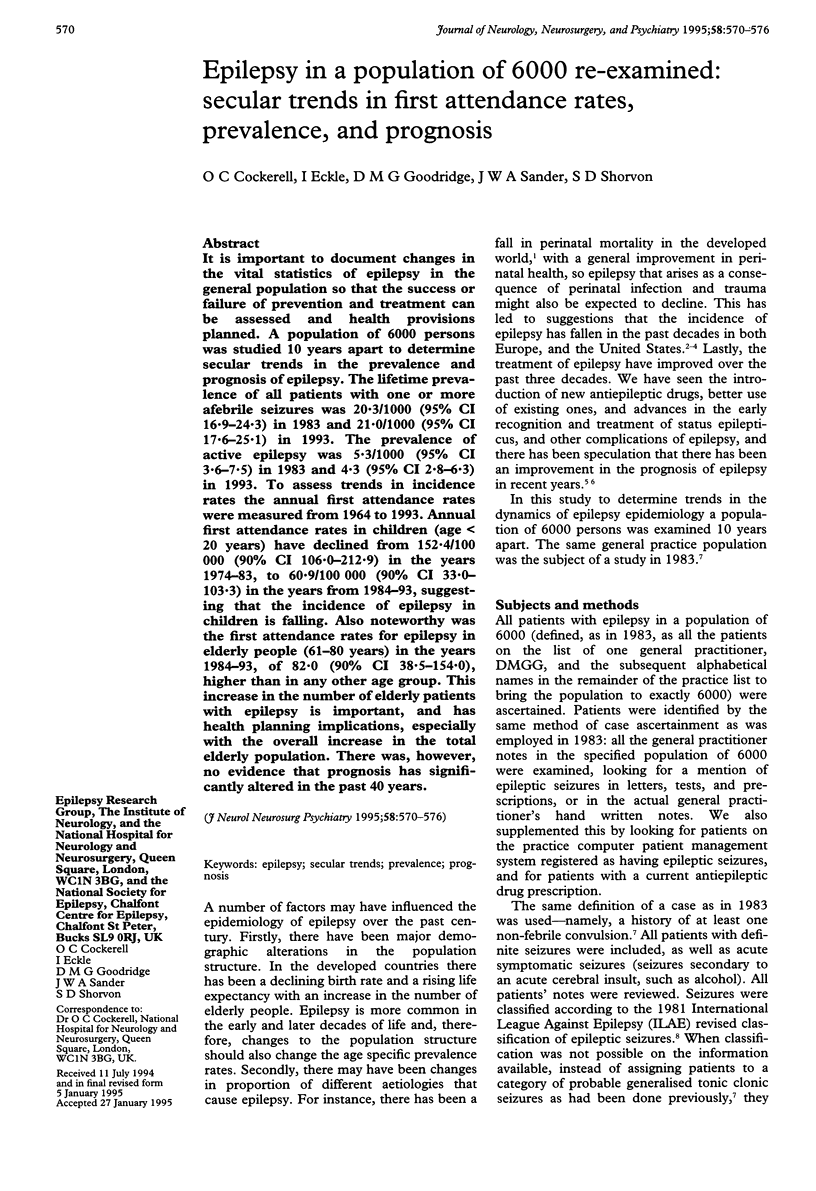
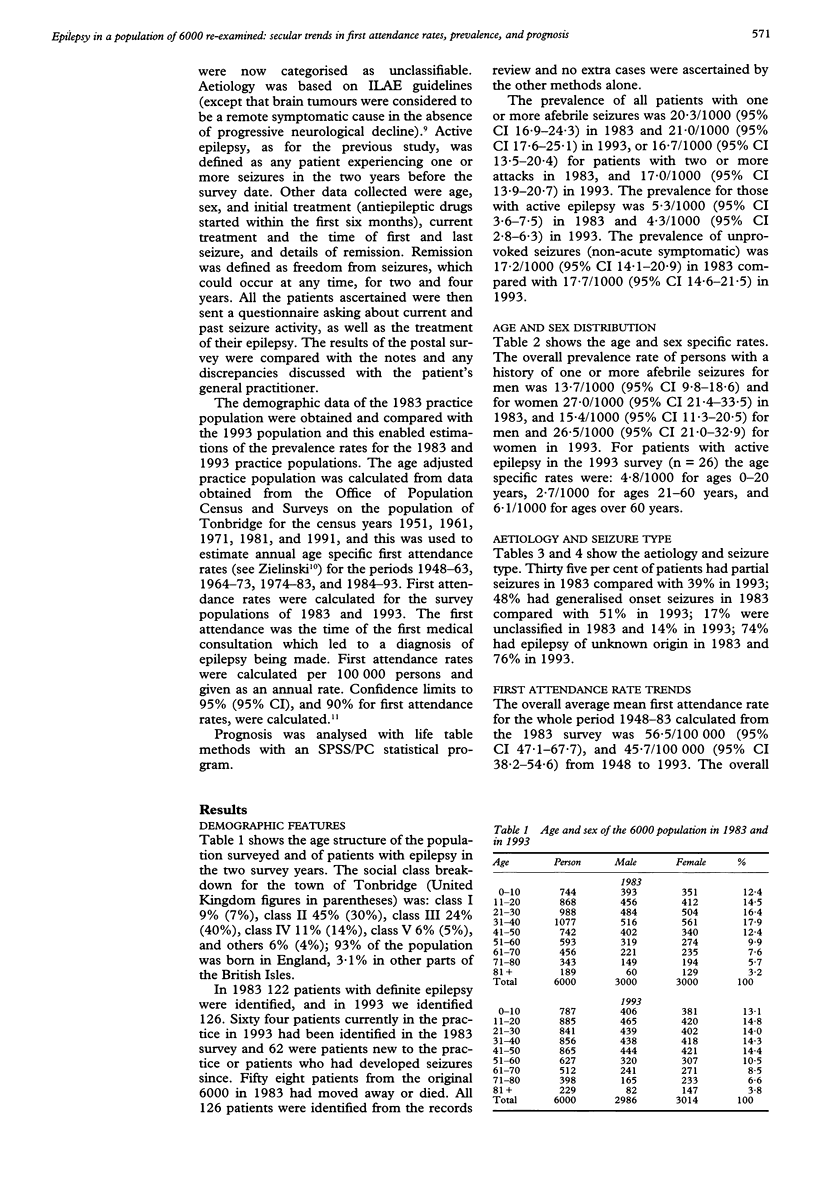
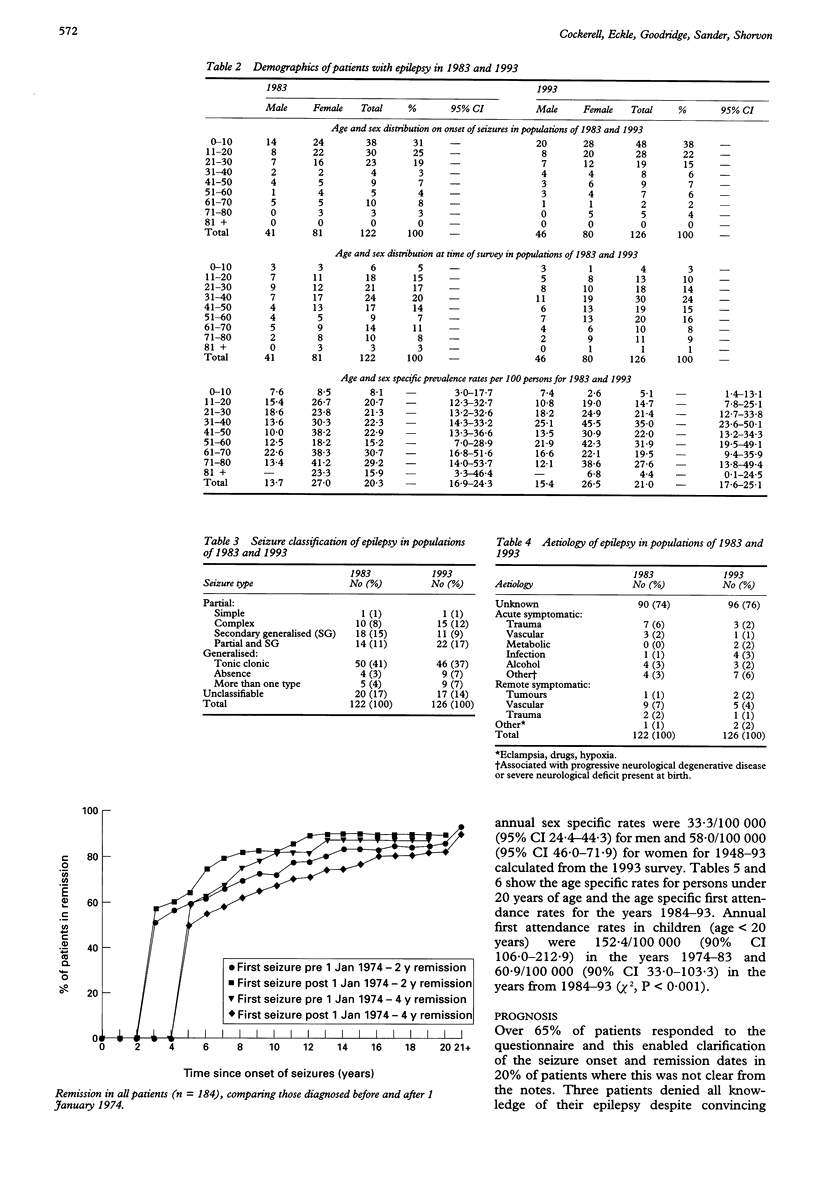
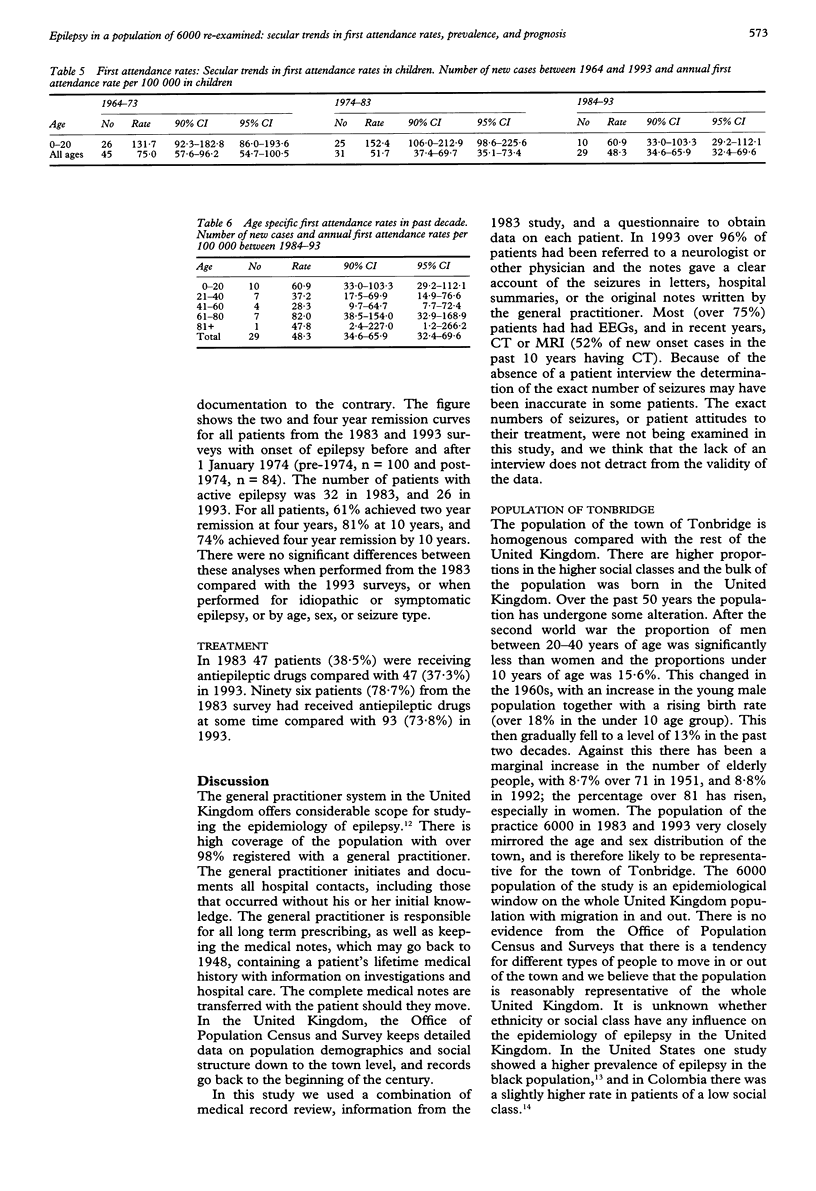
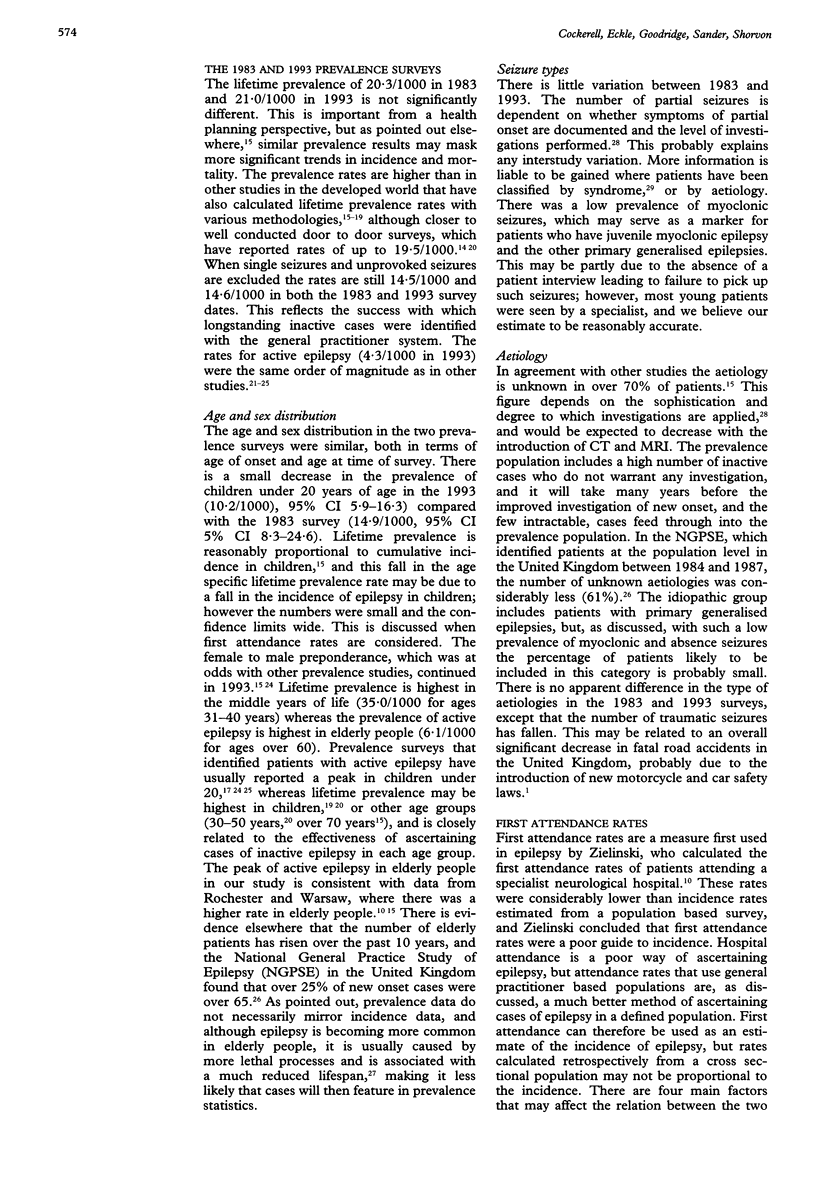
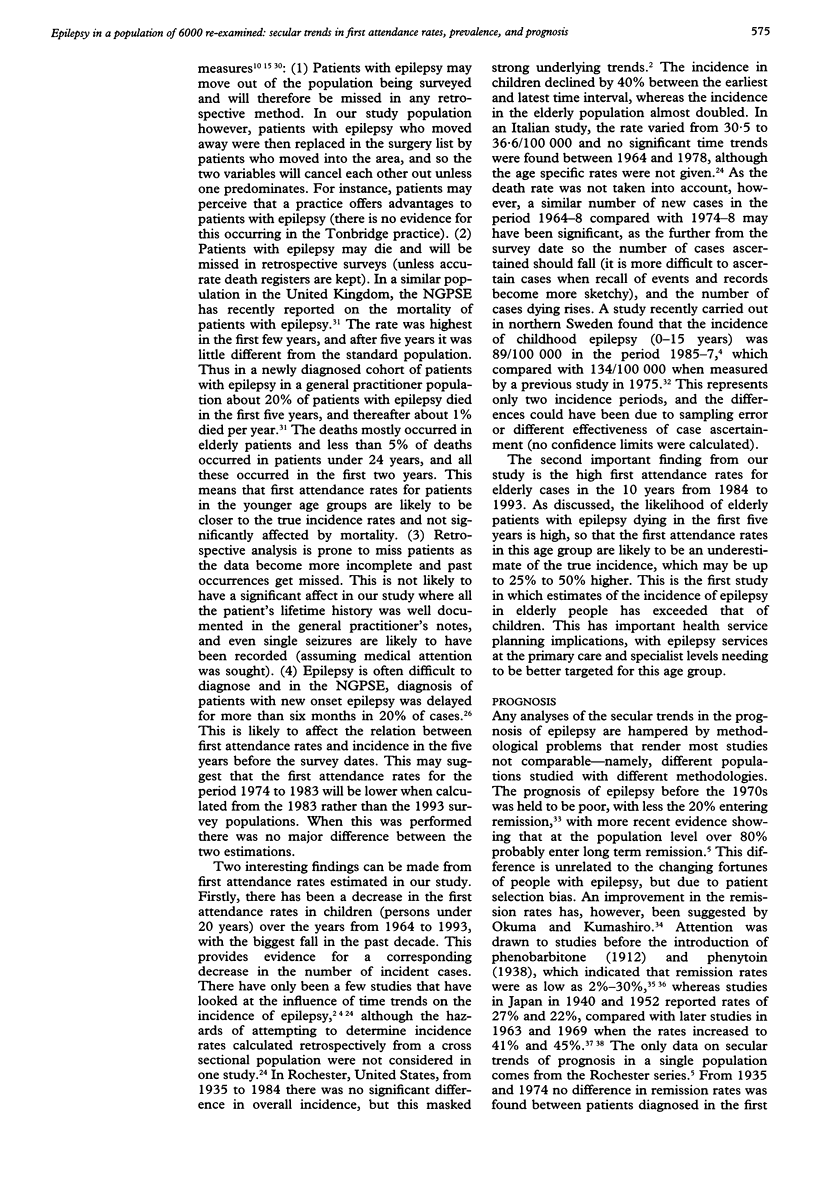
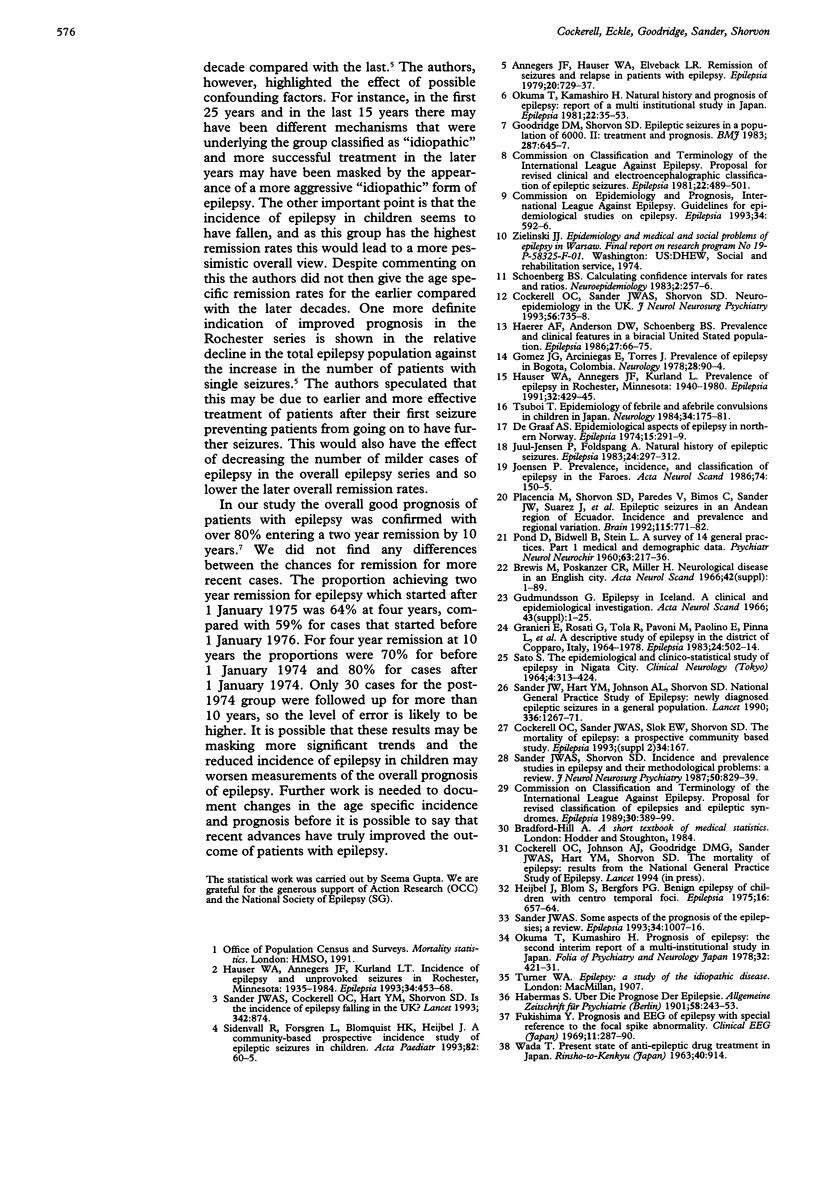
Selected References
These references are in PubMed. This may not be the complete list of references from this article.
- Annegers J. F., Hauser W. A., Elveback L. R. Remission of seizures and relapse in patients with epilepsy. Epilepsia. 1979 Dec;20(6):729–737. doi: 10.1111/j.1528-1157.1979.tb04857.x. [DOI] [PubMed] [Google Scholar]
- Brewis M., Poskanzer D. C., Rolland C., Miller H. Neurological disease in an English city. Acta Neurol Scand. 1966;42(Suppl):1–89. [PubMed] [Google Scholar]
- Cockerell O. C., Sander J. W., Shorvon S. D. Neuroepidemiology in the United Kingdom. J Neurol Neurosurg Psychiatry. 1993 Jul;56(7):735–738. doi: 10.1136/jnnp.56.7.735. [DOI] [PMC free article] [PubMed] [Google Scholar]
- Gomez J. G., Arciniegas E., Torres J. Prevalence of epilepsy in Bogota, Colombia. Neurology. 1978 Jan;28(1):90–94. doi: 10.1212/wnl.28.1.90. [DOI] [PubMed] [Google Scholar]
- Goodridge D. M., Shorvon S. D. Epileptic seizures in a population of 6000. II: Treatment and prognosis. Br Med J (Clin Res Ed) 1983 Sep 3;287(6393):645–647. doi: 10.1136/bmj.287.6393.645. [DOI] [PMC free article] [PubMed] [Google Scholar]
- Granieri E., Rosati G., Tola R., Pavoni M., Paolino E., Pinna L., Monetti V. C. A descriptive study of epilepsy in the district of Copparo, Italy, 1964-1978. Epilepsia. 1983 Aug;24(4):502–514. doi: 10.1111/j.1528-1157.1983.tb04921.x. [DOI] [PubMed] [Google Scholar]
- Gudmundsson G. Epilepsy in Iceland. A clinical and epidemiological investigation. Acta Neurol Scand. 1966;43(Suppl):1–124. [PubMed] [Google Scholar]
- Haerer A. F., Anderson D. W., Schoenberg B. S. Prevalence and clinical features of epilepsy in a biracial United States population. Epilepsia. 1986 Jan-Feb;27(1):66–75. doi: 10.1111/j.1528-1157.1986.tb03503.x. [DOI] [PubMed] [Google Scholar]
- Hauser W. A., Annegers J. F., Kurland L. T. Incidence of epilepsy and unprovoked seizures in Rochester, Minnesota: 1935-1984. Epilepsia. 1993 May-Jun;34(3):453–468. doi: 10.1111/j.1528-1157.1993.tb02586.x. [DOI] [PubMed] [Google Scholar]
- Hauser W. A., Annegers J. F., Kurland L. T. Prevalence of epilepsy in Rochester, Minnesota: 1940-1980. Epilepsia. 1991 Jul-Aug;32(4):429–445. doi: 10.1111/j.1528-1157.1991.tb04675.x. [DOI] [PubMed] [Google Scholar]
- Heijbel J., Blom S., Bergfors P. G. Benign epilepsy of children with centrotemporal EEG foci. A study of incidence rate in outpatient care. Epilepsia. 1975 Dec;16(5):657–664. doi: 10.1111/j.1528-1157.1975.tb04748.x. [DOI] [PubMed] [Google Scholar]
- Joensen P. Prevalence, incidence, and classification of epilepsy in the Faroes. Acta Neurol Scand. 1986 Aug;74(2):150–155. doi: 10.1111/j.1600-0404.1986.tb04642.x. [DOI] [PubMed] [Google Scholar]
- Juul-Jensen P., Foldspang A. Natural history of epileptic seizures. Epilepsia. 1983 Jun;24(3):297–312. doi: 10.1111/j.1528-1157.1983.tb04893.x. [DOI] [PubMed] [Google Scholar]
- Okuma T., Kumashiro H. Natural history and prognosis of epilepsy: report of a multi-institutional study in Japan. The group for the study of prognosis of epilepsy in Japan. Epilepsia. 1981 Feb;22(1):35–53. doi: 10.1111/j.1528-1157.1981.tb04331.x. [DOI] [PubMed] [Google Scholar]
- Okuma T., Kumashiro H. Prognosis of epilepsy: the second interim report of a multi-institutional study in Japan. Folia Psychiatr Neurol Jpn. 1978;32(3):421–431. doi: 10.1111/j.1440-1819.1978.tb02811.x. [DOI] [PubMed] [Google Scholar]
- POND D. A., BIDWELL B. H., STEIN L. A survey of epilepsy in fourteen general practices. I. Demographic and medical data. Psychiatr Neurol Neurochir. 1960 Jul-Aug;63:217–236. [PubMed] [Google Scholar]
- Placencia M., Shorvon S. D., Paredes V., Bimos C., Sander J. W., Suarez J., Cascante S. M. Epileptic seizures in an Andean region of Ecuador. Incidence and prevalence and regional variation. Brain. 1992 Jun;115(Pt 3):771–782. doi: 10.1093/brain/115.3.771. [DOI] [PubMed] [Google Scholar]
- Sander J. W., Cockerell O. C., Hart Y. M., Shorvon S. D. Is the incidence of epilepsy falling in the UK? Lancet. 1993 Oct 2;342(8875):874–874. doi: 10.1016/0140-6736(93)92737-e. [DOI] [PubMed] [Google Scholar]
- Sander J. W., Hart Y. M., Johnson A. L., Shorvon S. D. National General Practice Study of Epilepsy: newly diagnosed epileptic seizures in a general population. Lancet. 1990 Nov 24;336(8726):1267–1271. doi: 10.1016/0140-6736(90)92959-l. [DOI] [PubMed] [Google Scholar]
- Sander J. W., Shorvon S. D. Incidence and prevalence studies in epilepsy and their methodological problems: a review. J Neurol Neurosurg Psychiatry. 1987 Jul;50(7):829–839. doi: 10.1136/jnnp.50.7.829. [DOI] [PMC free article] [PubMed] [Google Scholar]
- Sander J. W. Some aspects of prognosis in the epilepsies: a review. Epilepsia. 1993 Nov-Dec;34(6):1007–1016. doi: 10.1111/j.1528-1157.1993.tb02126.x. [DOI] [PubMed] [Google Scholar]
- Sidenvall R., Forsgren L., Blomquist H. K., Heijbel J. A community-based prospective incidence study of epileptic seizures in children. Acta Paediatr. 1993 Jan;82(1):60–65. doi: 10.1111/j.1651-2227.1993.tb12518.x. [DOI] [PubMed] [Google Scholar]
- Tsuboi T. Epidemiology of febrile and afebrile convulsions in children in Japan. Neurology. 1984 Feb;34(2):175–181. doi: 10.1212/wnl.34.2.175. [DOI] [PubMed] [Google Scholar]
- de Graaf A. S. Epidemiological aspects of epilepsy in northern Norway. Epilepsia. 1974 Sep;15(3):291–299. doi: 10.1111/j.1528-1157.1974.tb04009.x. [DOI] [PubMed] [Google Scholar]


